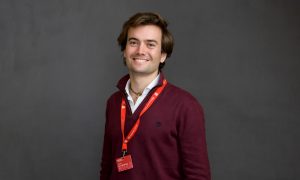
IESE´s Summer Entrepreneurship Experience (SEE) gives MBAs a chance to get real-world, hands-on learning on what it’s like to turn an idea into a business. Following our previous interview with Cassian Stanjek (MBA ’22), we sat down with Ignacio Guitard (MBA ’23) about what he got out of SEE 2022, and how it helped him with his startup Cirineo. Cirineo V is a social project that unites donors, beneficiaries, and local businesses. People donate through a monthly subscription or sporadic donation.
1. What did you get from being mentored by IESE´s faculty?
Focus. Many times, when you launch something, you are all over the place. In my case, I was initially preoccupied with the operations of the minimal viable product (MVP). After speaking with IESE´s Mauricio Prieto and Matthieu Carenzo, I refocused on the most important point: product market fit. They stressed how relevant product market fit is, and the various iterations you need to make to achieve your goals. Also, they give you the freedom to create. They don’t tell you the answers, but they help you focus on what is important.
2. For you, what are the main benefits of the Summer Entrepreneurship Experience (SEE)?
Impetus! It’s hard to create an entrepreneurship program that can cater to projects at so many different stages. I would say that, in general, the main virtue of the program is that it pushes you to make the most of what you have. Then, it is up to you answering to the challenge. Thanks to the SEE, many people made amazing progress with their projects over the summer.
3. Why would you recommend the SEE to an MBA student?
First, because you are dealing with people that know what they are talking about. Second, in the entrepreneurial space, there is always lot of talking and sharing ideas, but you need to get your “hands dirty” to learn properly. Maybe, once you are a successful entrepreneur, you can launch your start-up with just an idea; but for those just starting out, getting hands-on experience in a safe and supportive environment makes all the difference.
4. How does the SEE complete the training of the entrepreneurship Fundamentals subject in the first year?
The Fundamentals class is more strategic – prepare a pitch, what is an MVP, rich Vs king conversations, etc. But the SEE is different. It’s more like: There’s a full day in front of you! What do you? How do you make your company better? What’s the next step? How do you use your time better? Taking the two together really gives you the solid grounding needed to take the next step in your entrepreneurship journey.
5. What do you think is a unique thing that the SEE can provide for a project like Cirineo?
A reality check. Being at a top business school makes you think you are already at the peak of the mountain. You realize that’s not true. In operations class, we learned that scarcity generates the brightest ideas. We live in an ecosystem (Europe, particularly Spain) that is way more challenging than other places such as the US. Being part of the SEE makes you realize that the challenge is great and that every step must be solid to succeed.
6. What was for you the best of the SEE format? (The contacts, the sessions, the times…)
Mentorship and getting to know other people’s ideas. The speaker series was excellent too.
7. In the case of Cirineo, in what part of the business did the SEE especially help you? (Logistics issues, business model, market implementation…)
Product market fit. You can have a million-dollar idea, but if you don’t know how to put it out to the market then it’s worthless! Fighting for new channels, trying new campaigns, talking with key people…. Increasing the number of sales was the main point I took from the SEE.
8. From your perspective, how should a first-year MBA student approach the SEE?
SEE shouldn’t be a plan B for your corporate internship. It should be your main focus since day one. If you don’t have an idea but still want to do the SEE, then get obsessed with another person’s idea. Only with that mindset will you avoid surrendering when adversity hits.
9. Is there anything you would have done differently if you did the SEE again?
More networking with the people of the SEE program. Family and other duties complicated this a little bit!
10. What was the main difference in your project when you started the SEE and when you left?
We are taking off! From six families involved in the project to 22. From 13 donors to 71. From €300 per month to €1,000 per month in donations.
11. What challenges are you facing now at Cirineo?
Seal the product market fit and verify the second monetization assumption to convince investors that their money could not be in a better place than in Cirineo. This is crucial if you want to change how solidarity operates today.
Thanks Ignacio for sharing your experiences!
Are you interested in finding out more about the SEE? Get in touch with us here.

